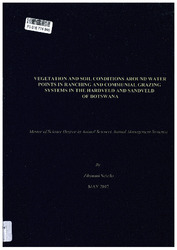| dc.description.abstract | Artificial water sources or boreholes were introduced in Botswana to mitigate surface water scarcity in rangelands and aid livestock production. Gradually piospheres were observed, areas close to water points experienced high grazing pressure, trampling, and excreta deposition as animals congregate at a reduced area for water, causing changes in vegetation and soil conditions. The magnitude of grazing and animal movements reduces as animals move away from water points as an area of impact increases. Nonetheless, whether the above phenomenon takes place in different grazing management systems and ecological zones is poorly understood. Therefore the objective of this study was to investigate the effects of distance around water points, grazing management systems (ranches and communal grazing areas) and ecological zones (hardveld and sandveld) on vegetation and soil conditions. Vegetation conditions included grass species abundance, woody plant density, and plant diversity (grass and woody) and soil conditions included soil pH and mineral status. In each zone, 2 ranches and 2 adjacent communal grazing areas were used for this study. One water point was used as a reference point for 4 randomly placed transects of 1000m in length radiating in different directions from the water source at each site. Four plots measuring 50mx20m were placed at intervals of 250 m along each transect. Within the 50m.x20m plot, grass species abundance was estimated in a 10mx10m plot while woody plant density was estimated in the 50mx20m plots. Shannon-Wiener index was used to calculate plant species diversity. For soil conditions, soil samples were collected in the first and last 50mx20m plots along each transect. At each sample plot, a soil sample was collected as a composite sample from 5 randomly collected samples that were mixed together in a bucket. From the mixture a composite soil sample was collected so as to avoid small spatial 1variations. All soil samples were analyzed for soil pH, macro (Mg, Ca, K, Na, P and N) and micro (Fe, Mn, Zn and Cu) minerals. Total grass species abundance, woody plant density and plant diversity were not affected by distance from water points (P>0.05). Ranching and communal grazing management systems also did not affect total grass species abundance and woody plant density (P>0.05). However, strong perennials, decreaser, increaser I, good and poor palatable grass species abundances were significantly higher in ranches compared to communal grazing areas (P<0.05). Grass and woody species diversities were higher in ranches than in communal grazing areas (P<0.05). Woody plant density, total grass species, strong and weak
perennial, decreaser, increaser 1, increaser II, high, moderate, and poor palatable grass species abundance differed between the hard veld and sand veld ecological zones of Botswana (P<0.05).
Woody plant diversity differed (P<0.05) between ecological zones whereas grass species diversity did not vary between ecological zones (P=0.32). Woody plant diversity in the sand veld (1.78±0.06) was higher than in the hard veld (1.29±0.06; P<0.0001). Soils further away from water points were acidic compared to those close to water points. Ranches (5.10±0.13) had less acidic soils than those in communal grazing areas (4.71±0.13; P=0.03). The hardveld (4.94±0.13) and sandveld (4.88±0.13) had similar soil pH (P=0.73). Macro and micro minerals were not affected by distances from water point except for calcium which was highest further from water sources. Generally, soil mineral status was higher in ranches than communal grazing areas. Variations between the two grazing management systems were found in Mg, Na, P and Zn contents. Soils in the hardveld had higher soil mineral status than the sandveld. This study did not find evidence that distance from water points causes changes in vegetation and soil conditions. However, grazing managements systems and ecological zones did influence some variations in vegetation and soil conditions. Ranching grazing management system showed 2 higher-good grass species abundance, plant diversity and soil mineral status than communal grazing systems. The hardveld also was higher in good grass species abundances and soil
mineral status than the sandveld. For livestock production to be sustainable in the sand veld
mineral supplementation is required to argument low mineral status of the soil. It is recommended that the following may be considered for future studies; 1) observe more (2-4) communal and ranching grazing management systems in each ecological zone, 2) have longer transects (preferably longer than a kilometer) with shorter sampling intervals, 3) measure soil physical and mineral properties of a complete soil profile so as to measure grazing effects over time and 4) measure vegetation growth (above and belowground biomass, cover, and height) of grasses. | en_US |

